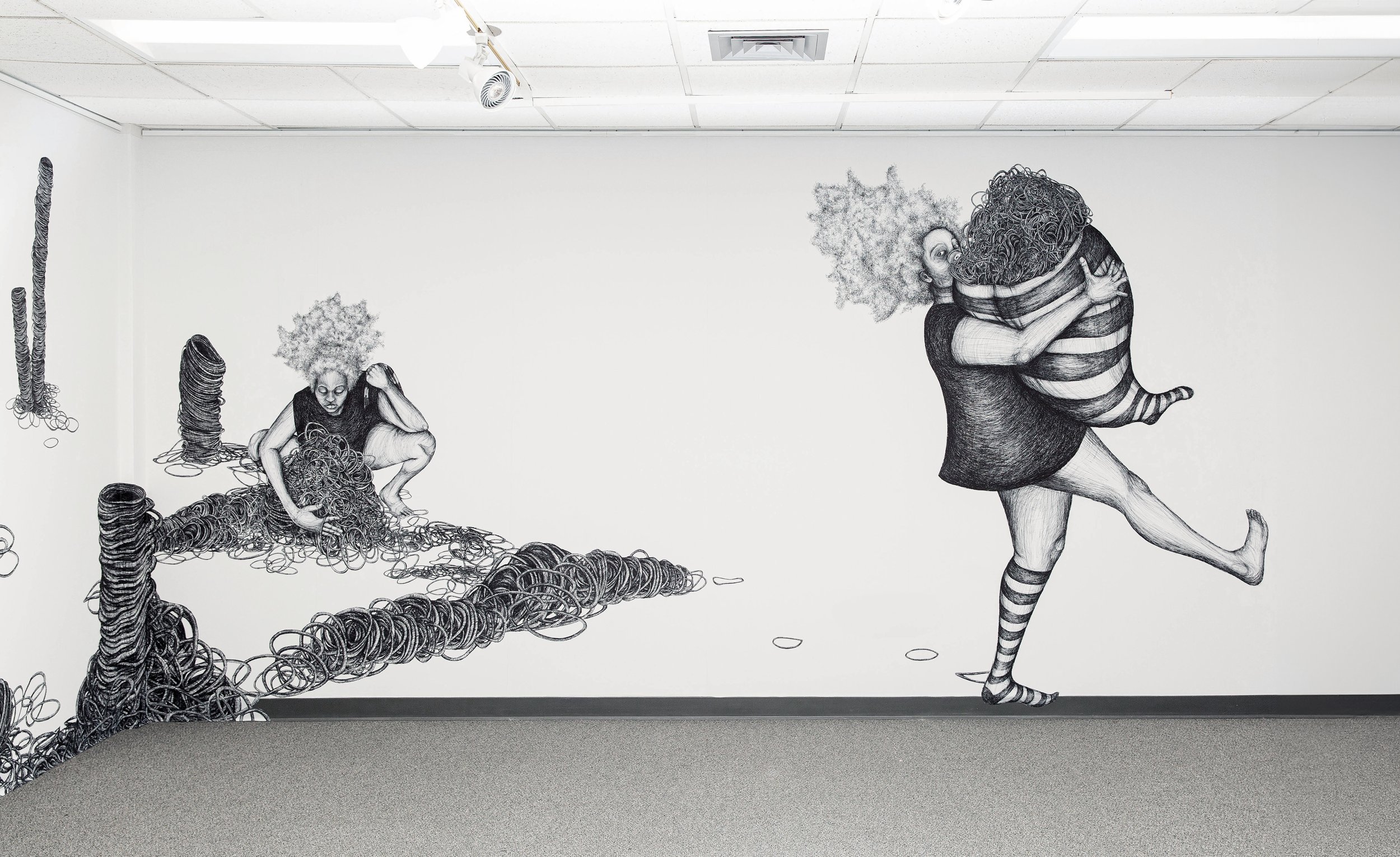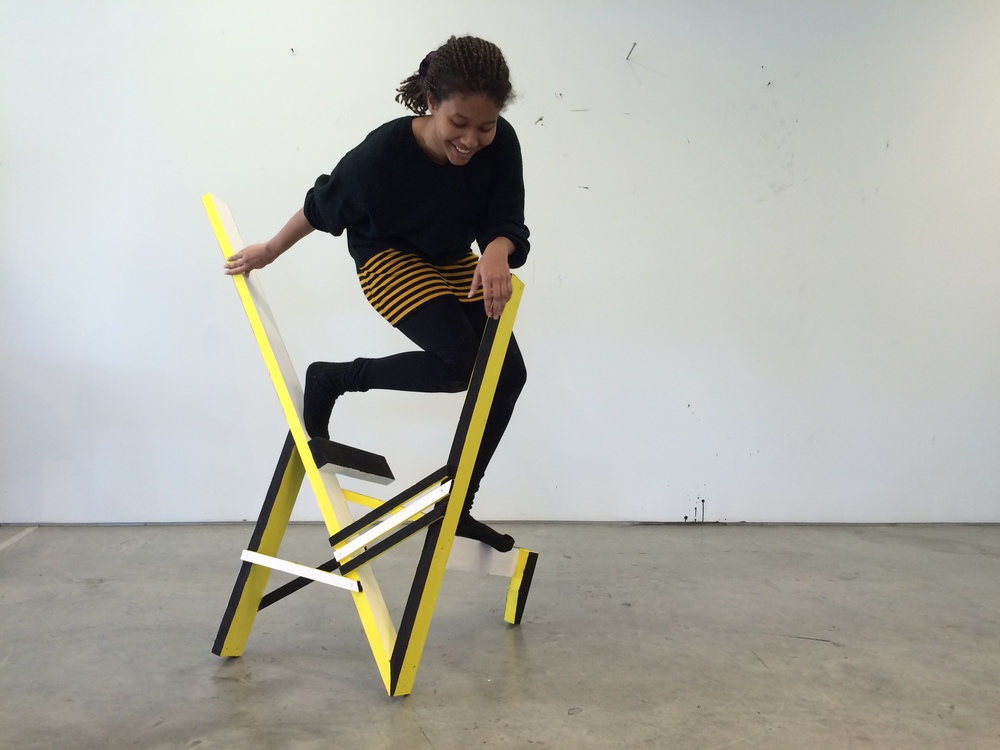Samantha Modder is a Nigerian Sri Lankan artist drawing Black people in all their texture, vibrancy, and power. She currently works at the University of Tampa as an Assistant Professor of Art and Design. The beautifully intricate drawings that she has become known for take place on massive scales, covering entire walls of exhibition spaces and looming over viewers as well as immersing visitors into her carefully created and fantastic worlds. ATA is fortunate enough to exhibit one of her works, Wearer of All Socks, in our current W.O.W.: Women’s Outstanding Work 2024 show. In my interview with Sam we discuss her staunch advocacy of her own experience with fine arts education, influences of her life experiences living in Sri Lanka as a Black woman, and delve deeper into a handful of her most prominent works…

Modder standing beside Wearer of All Socks, currently on exhibit at the ATA gallery. Photo by Richard Spengeler.
I began with discussing her impressive educational background. Modder currently has her Bachelor degree and recently earned her Masters of Fine Arts.
ELLA: How has your education influenced your art? Has it influenced how you approach creating and understanding art in general?
SAM: In my undergrad I double majored in mechanical engineering and studio art. For me as an immigrant coming to the US it was a bit nerve wracking to only do art and my parents were also nervous so I decided to do mechanical engineering because I thought it was the most creative form of engineering. And I have worked as an engineer for about two years before grad school. Then I got my MFA, which is really influential. I actually started a lot of the work that I make now during my MFA program.
My MFA was really instrumental because it created the time and the space to experiment and try different things. Throughout undergrad and even after I graduated, I was always back and forth – doing my engineering classes, and then doing art classes. [Art] was always something that I loved but I had to squeeze into my free time. Even when I was working, I’d go to work and on the way home or in the evenings I would draw. So my two year MFA program was the first time that I had 24/7 to think about art, make art, take classes about it, see other people’s work – to really immerse myself. And that created exponential growth for me because of the focus I could now dedicate and the increased access to resources I had. In undergrad I had access to studios but they were shared and I also didn’t know… I mean, I knew something but I’m better now.
Here Sam humbly reflects on her growth, giving grace to her younger undergraduate self and advocating for the MFA program she completed at Washington University in St Louis.
SAM: It’s understandable. I mean in undergrad you’re still learning, like, “how do I do anything?” But like, in my MFA program I had access to large printers and large walls. And if you had an issue you could simply ask an expert. I think all of that really helped.
She goes on to explain how she finds uses for her engineering degree, if indirectly, through the problem solving lessons it taught her.
SAM: So I don’t really use it at all now but I think it was helpful because engineering is very problem solving based. Especially mechanical engineering leans heavily on design and the human experience, and so I think I still adopt some of those ideas in my work. For example, I always think about how people will approach the work as the audience.
After a pause I tell Sam that I relate to that feeling of needing to add something to your degree since my own degree is in English and Art History, two departments which create an intimidatingly broad pool of possible careers and do not have a reputably stable job market to enter after graduation.
SAM: I think it’s a smart thing. I think if you can squeeze it in and you enjoy both and it’s not sucking your soul, I’m all for it. I don’t think engineering sucked my soul; I do love math. You never know what you’re going to use at the end of the day.

From Modder’s series Larger than Life (2019-2020) where she reclaims the streets of her hometown. This piece is titled Kandy Lake.
We moved on to discuss her cultural affinity and histories. Modder was born in Nigeria and raised in Sri Lanka and now lives in the United States.
ELLA: How would you say these countries have shaped your childhood? Has your family played a role in the creation of and inspiration for your art? And how do you remain connected to your roots now living in Florida?
SAM: I was born in Nigeria but I didn’t grow up there. That connection has always been through my mom and through the food my mom would cook or the music she would listen to and even just fabrics. I have a lot of fascination and adoration for Yoruba Nigerian culture and as I’ve gotten older I’ve tried to learn more but it isn’t something that I necessarily grew up with. On the other hand, Sri Lankan culture is something that I did. It [Sri Lanka] is also a part of me that has always been a bit difficult. When you look at me I look black, and Sri Lankans aren’t black. So growing up everyone would say, “You’re not Sri Lankan, you’re Nigerian”. I think for me, my art has always been a very safe place. My work isn’t really about my Nigerian or Sri Lankan identity; it centers me in an imaginary world. I think I do that because that is what I know. I feel like if I was to make work about the Sri Lankan experience, or the Nigerian experience, or even the American experience, I wouldn’t be able to speak completely truly to it because I’m not completely that, you know what I mean? But I can take ownership in these imaginary spaces.
So in this world where there’s hair ties and hair monsters and whatever I want, no one can say, “No, that’s not what’s happening”. For me, my art is comforting. There’s ways that I can make references to aspects of Nigerian culture or things that I’m noticing in Sri Lankan imagery, but I don’t have to tie it directly. In some ways, my work is a way of processing. As I’ve gotten older and I’m feeling like less of an imposter in these cultures I see it seeping into my work. So I’m sure it’ll progress as I age.
Much of her work relates to a variety of subjects and Modder’s online website (sammodder.com) boasts a huge diversity of mediums. I note this diversity to her, listing that she has worked with pastels, painting, and even wood sculptures.
SAM: So that’s the great thing about college – you do all the things. As I’ve gotten more into it, I’m narrowing down [my style]. I teach and my students are always asking, “what’s my style?” and I always tell them it’s too early. I say, “Just experiment. It’ll come naturally”. If you look at my older stuff it’s a lot of different things but you can probably see some connections. Now, I’ve leaned into fewer ways of working.
ELLA: And it just felt right to choose the format you work with now which is the ballpoint pen drawings?
SAM: Yes. I know a lot of artists who still experiment and play and that’s a big part of what they do but for me, the ballpoint pen, the drawings, and the scale are things that I’m comfortable with to the point that I can explore more complicated content. Essentially, because I know how to do the things I can challenge myself further in alternative ways. In other words, if I was to try making a painting I wouldn’t have the painting skills to pull it off. And I don’t want to do that; I’m not a painter, I am an installation drawing artist. I still experiment with different styles when I make zines and stuff because that’s different in my head. It’s a different part of me so I feel more free to experiment there. With my more recent work I feel like I have to say something important so I lean into what I know and what I can pull off really well.

One image from series, Planning my Escape (2020-present).
ELLA: I wanted to ask about your most recent work, Wearer of All Socks and the Field of Lost Hair Ties. Can you walk me through how those artworks came to be and what message you’re trying to get across?
SAM: That work started during COVID when I was spending a lot of time with myself. It started with a portrait I made during quarantine where I’m growing a person out of my hair. When I got to grad school, that piece began to feel like the beginning of a story. In fairy tales there’s this idea of a herald, basically a person who pulls you into the adventure. If you think about the Princess and the frog, the frog appearing acts as the herald. In my case, that piece made me think, “there’s something weird here that’s going to start a journey”. When I was trying to picture the journey, I imagined that person [the person made of hair] tells me “this world is so messed up, why don’t you leave and go to another place that’s just you?” And so she’s in this night dress and stripy socks. I took that character and wondered how I could make a world out of these building blocks.
Every piece in this series is an evolution of those blocks. From the socks I made Wearer of All Socks which was the third or fourth piece from that initial idea. [Wearer of All Socks] was based on this question: If you had a bunch of socks and wanted to make a fabulous dress, how would you pull it off? And so you have this impressive, powerful figure who has seemingly gathered all of the socks. You know typically people only get two socks but she’s got all of them so she’s impressive but maybe she’s not the greatest person when you consider where did she get all her socks from?
ELLA: I see it! There’s something sinister there.
SAM: I know! She’s a little sinister because on one hand, she’s so awe inspiring but on the other… Where is she getting all these socks from?! If you look at some of the other pieces like Source of All Hair where small characters are pulling socks off of each other or Sock Factory where you see workers pulling socks directly off other people’s feet, they make you think. In order for her to have that many there must be a lot of people walking around without socks. So she’s not the greatest but she is still this queen character. Her positioning is very inviting, as if she’s leaning in to tell you something yet she’s also a little scary, a little intimidating. I’d say she’s a bit of an ambiguous figure.
So, I made her in 2022. Field of Lost Hair Ties I made last summer [2023]. There were a lot of forest fires then and I was thinking about overconsumption and how afraid we are of running out of things. Field of Lost Hair Ties plays on the practice of how we’re always losing hair ties, always buying hair ties, and the question of where do all the hair ties go? And so you can see that they [the hair ties] become forests. You have this character who at first is in awe but then starts grabbing as many hair ties as she can. She even starts stuffing her socks with hair ties. Why do you need that many hair ties right? You probably just need one or two.
My more recent piece, Jagun Jagun, is like a war tower. It is based off of a Yoruba mask that’s used in ceremonial festivals, but it’s my own version. You have the main characters who are strong and you have these tiny people flying off. In that piece I am thinking about the effects that war has on the most vulnerable in society. It’s all a fairy tale and so it can be fun and games, but hopefully the text makes it a bit more sinister and confrontational.

From the series, Field of Lost Hairties.
ELLA: Do you still take pictures of yourself before translating the image into your art? I imagine this process sort of instills a version of you into the artwork in a more literal way than some others. How do you find this method helps you?
SAM: Yes, all the characters are based off of me and I do model all the poses. I have not reached peak figurative knowledge to know how to draw without a reference so if I get an idea, I will first act it out and then draw myself and of course add things.
ELLA: Do you feel like this connects you more with the piece since you are using a reference of yourself?
She laughs here, joking… It’s very egocentric right? At this point I’ve just drawn myself multiple times… but she continues seriously.
SAM: I think for me it’s about ownership. I’m not claiming to be someone else’s experience. It’s my experience. It’s my character. And for me, I believe it’s especially good because I’m not drawing good characters or bad characters. I’m just drawing greedy, flawed human beings and so it’s important to me that I’m not blaming someone else because I could draw the evil characters into a stereotypical fat old white guy. But, I’m trying to critique myself or what I’m capable of. If I was put in certain situations and I had all the power… “Would I make a better decision?” I don’t know. I might, or I could succumb to all of these other things. It’s important to draw myself in all these possibilities to think of my own role in it. That’s how I view it as the artist but I think for other people viewing it there’s something to be said about seeing a black woman as the center of this adventure.
ELLA: My last question is what athlete was your piece with the two by four wood planks was meant to mimic?
Sam’s face breaks into a wide smile at the mention of her college assignment and she laughs.
SAM: Oh my gosh, that was Professor Soo Sunny Park who is amazing. She was my drawing and sculpture professor. We still keep in touch. She’s honestly the hardest but coolest professor I’ve had and she had these impossible assignments. You were supposed to use two pieces of two by four to make a sculpture that balanced you in a pose. And it could only touch the ground at three points. At that point we had no knowledge of anything. It was the project that was meant to teach us how to use the woodshop. I think I started off with one idea and in the end I decided I just had to make it work. I was a football player. It broke the night before I was supposed to submit it. I stood on it and it just collapsed so I had to figure out how to secure it. I think it was my freshman year and so it was a very stressful night. And then in the end it worked out! I definitely recommend taking a stressful sculpture class because that’s when I realized that I’m not a sculptor.

Modder’s assignment for her undergraduate professor where she is mimicking a football player.
ELLA: That’s all my questions! If you have anything that you wanted to add, anything you’re working on…
SAM: There will be some more shows coming up which I’m excited for. And I’m working on a new set of pieces this summer. The first is Mountain of Rest. I’ve been thinking a lot about rest, taking a break, and dreaming and the role they play in resistance. There’s a book called Rest is Resistance by Tricia Hersey. I wanted to make this mountain of rest with characters sleeping in different positions which will become a landscape. I’ve been thinking a lot more about the natural world and landscapes and things. So that’s a new piece that I’m working on which hopefully I’ll be able to exhibit either at the end of this year or early next year. And I have another piece that I still haven’t figured out what it’s called which will involve a lot more movement and dancing.
In our parting words to one another I mentioned that I was, a bit apprehensively, entering my last year of university and nervous for the transition into the “real world”. Her response, I think, can be both reassuring and applicable to my fellow students.
SAM: Honestly, you’re going to be fine. College is so hard and life gets hard too but in a different way. I have not pulled those academic stress infused all-nighters as much as an adult; there’s no more thinking ‘I’m going to fail a class and I have to work until the sun rises’. Don’t worry. You are well prepared for the real world.
